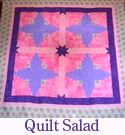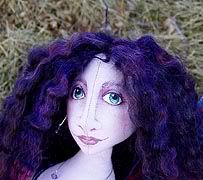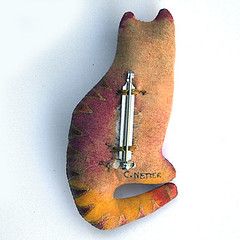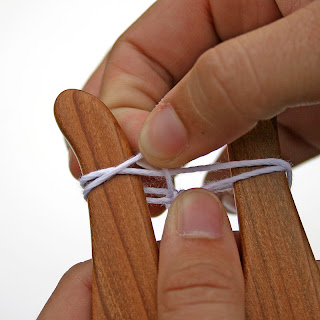Friday, December 21, 2012
Winter Solstice Sunset
As I post this, the sky is black out and it is only 5 o'clock on the shortest day of the year. It was a beautiful day. The temperature reached a comfortable 50 F. The last day of the Mayan calendar ended with a beautiful sunset - in the east. Here in Colorado our entire sky can fill with intense colors of the sunset. Today, the color was just in the east since that was where the clouds were. The west was clear.
Wednesday, December 5, 2012
Tiny Handmade Mermaid Dolls
 |
| Mermaid 2 |
 |
| Mermaid 3 |
 |
| Mermaid 4 |
Tuesday, November 6, 2012
Lucet Tutorial - Square Cord
In my last Lucet post, I posted an image of the simple instructions included with the Lucets I sell. I thought it might be a good idea to do a more elaborate tutorial that includes some tips on what I've found helpful.
The lucets I use are ones I make. I've left off the handle found on some lucets since it just seems to get in the way. Also, I made them bigger than some, with a round bottom that fits comfortably in the palm of my left hand.
Tutorial:
1. Hold the lucet in your hand, cradling it comfortably in your palm. If you are right handed, hold it in your left hand, otherwise hold it in your right hand. Hold the ball of yarn, cotton string or whatever you will be making cord with in your other hand.
 |
| Cradle the lucet comfortably in your left hand |
2. Pass the tail of the yarn through the hole in the lucet. Hold this tail with your thumb so the yarn won't slip while you wrap the ball end of the thread around the horns of the lucet. First, wind it around the front of the right horn, then over and in front of the left horn. The yarn should make a figure eight.
 |
| The yarn should make a figure eight around the horns |
3. Bring the yarn back across the front the of the right horn and hold it there. You can hold it in place by grabbing it between two fingers of the left hand behind the lucet while you do the next step.
4. Pinch the lower loop on the right horn between your thumb and finger of the right hand and pull it up and over the horn.
 | |
| Pull the lower loop up over the horn. |
5. Rotate the lucet right over to left. Then pull on the yarn to tighten the cord.
 |
| The lucet is rotated, cord tightened and the yarn is brought across the right horn again. |
6. Bring the yarn across the right horn again and grab the loop as before to bring it up and over the horn.
 |
| Grab the loop as before and bring it up and over the horn |
 |
| Loop is now over the horn |
7. Rotate the lucet right over left again and tighten the cord. You want to snug up the knot, but don't make it too tight or you won't be able to pull enough cord through this knot to continue.
 |
| Rotate the lucet and tighten the cord |
8. Repeat this step until the cord is long enough. The cord should have four sides.
 |
| Closeup of the cord |
9. To end the cord, cut the yarn a few inches from the loops. Thread it through the loop on the right horn. Slip this loop off the horn and pull on the yarn until this loop is closed. Then thread the end of the yarn through the loop on the left horn, slip this loop off and pull until this loop is closed.
10. Thread the end of the yarn through a large needle and hide the end of the yarn by taking a few stitches in the end of the cord and then cutting off the excess. Do this to the extra yarn at the other end of the cord as well.
Some more hints:
Starting a cord is the hardest part. You need to have a good grip on the end of the cord with your thumb while pulling the yarn tight. Once a few knots are made and the cord starts to take shape, it's much easier to continue. Try to keep even tension when pull the cord tight and the cord will be more consistent.
Some yarns are easier than others. Wool is nice and springy and makes a stretchier cord. Cotton can have a lot of friction when pulling the cord which can make it more difficult to pull a loop up, especially if the knot was pulled very tight. Rayon is more slippery and makes a very nice cord.
Some people might find it easier to start off giving the lucet one more turn and then pulling the yarn up over the left horn instead. I find it easier to do cotton this way. The yarn is then pulled tight before doing the next rotation.
1. First, I turn the lucet one more time to wrap the yarn around the left horn and then I grab the lower loop from the inside of the left horn.
2. Lift the loop up over the horn.
3. Pull the yarn to close the loop and snug up the knot.
4. All snugged up. Time to rotate the lucet again and repeat.
Friday, November 2, 2012
Bee Town USA: An Educational Tiny Town of Beehives
 |
| Honeybee - Apis melifera photo by C. Netter |
Labels:
bee,
beehives,
beekeeper,
bees,
bumble bee,
Dakota Bees,
honeybees,
Native bees,
pollination,
pollinators
Wednesday, October 31, 2012
Happy Halloween!
Our Halloween Jack-O-lanterns right now.
Here's mine, freshly carved.
Here's Emily's and my pumpkins, earlier in the evening.
Emily also carved a mini pumpkin and a gourd.
Here's mine, freshly carved.
Here's Emily's and my pumpkins, earlier in the evening.
Emily also carved a mini pumpkin and a gourd.
Labels:
Halloween,
Jack-o-lantern,
pumpkin
Tuesday, October 30, 2012
New Lucets for the Sale
The Handweavers Guild of Boulder annual sale is allowing tools to be sold this year, provided they are made by the member selling them. So, I made some new lucets for the sale.
I've blogged about lucets before, when I was making cord for my husband's poet shirt. The lucet is a very old tool that is used for making cord. It is related to the knitting nancies that we made as kids out of an old wooden spool and 4 or more nails. The lucet has just two prongs which the string or yarn is wound around and looped over to create a cord. Depending on how the cord is looped, a square cord or a flat cord can be made.
I usually use it to make square cord out of cotton yarn, which is perfect for shoe strings, cord to lace up poet shirts or for drawstrings on pouches. It also makes a great cord for corsets that is much less likely to slip than ribbon or satin cord.
Years ago I made some lucets for largess and for my own use. I researched them a bit and then drew up my own pattern that fit comfortably in my own hand and was able to be be turned easily. I left off the handle that is often on lucets because I just couldn't see a use for it and it looked like it would only get in the way.
I ended up making six lucets total, including the one pictured at top. Three out of cherry and three out of walnut. In the future I'll be making some out of birds eye maple too, once the beautiful piece of maple I acquired gets resawn and planed into the correct thickness. I use only hard woods that can be polished very smooth.
I've included cotton velvet pouches with the lucets I'm selling. I bought two large bolts of gorgeous cotton velvet years ago to make period dresses that will now never get made so it seemed like a good way to use up the velvet. The drawstrings are all made using a lucet. I always keep my lucet in its pouch when not in use, along with the yarn for the current project.
I also drew up some instructions to be included with the lucets being sold. These are very basic instructions for making a square cord, which is the easiest cord to make on a lucet. I'll be elaborating on these instructions soon when I post a tutorial and will follow with more tutorials on how to make flat cord as well.
I've blogged about lucets before, when I was making cord for my husband's poet shirt. The lucet is a very old tool that is used for making cord. It is related to the knitting nancies that we made as kids out of an old wooden spool and 4 or more nails. The lucet has just two prongs which the string or yarn is wound around and looped over to create a cord. Depending on how the cord is looped, a square cord or a flat cord can be made.
I usually use it to make square cord out of cotton yarn, which is perfect for shoe strings, cord to lace up poet shirts or for drawstrings on pouches. It also makes a great cord for corsets that is much less likely to slip than ribbon or satin cord.
Years ago I made some lucets for largess and for my own use. I researched them a bit and then drew up my own pattern that fit comfortably in my own hand and was able to be be turned easily. I left off the handle that is often on lucets because I just couldn't see a use for it and it looked like it would only get in the way.
I ended up making six lucets total, including the one pictured at top. Three out of cherry and three out of walnut. In the future I'll be making some out of birds eye maple too, once the beautiful piece of maple I acquired gets resawn and planed into the correct thickness. I use only hard woods that can be polished very smooth.
I've included cotton velvet pouches with the lucets I'm selling. I bought two large bolts of gorgeous cotton velvet years ago to make period dresses that will now never get made so it seemed like a good way to use up the velvet. The drawstrings are all made using a lucet. I always keep my lucet in its pouch when not in use, along with the yarn for the current project.
I also drew up some instructions to be included with the lucets being sold. These are very basic instructions for making a square cord, which is the easiest cord to make on a lucet. I'll be elaborating on these instructions soon when I post a tutorial and will follow with more tutorials on how to make flat cord as well.
Labels:
lucet
Monday, October 1, 2012
The Fleece from Mr. Black
 |
| Mr. Black |
 |
| Chris and Mr. Black's fleece |
Here is a closeup of the fleece. Look at the nice crimp and staple length.
 |
| Chris, Cheryl and Lacey |
 |
| Lacey |
Labels:
Agave Alpacas,
alpaca,
Ancient Treasures Alpacas
Tuesday, September 4, 2012
Zucchini Fritters
It's that time of year when a zucchini grower gets desperate to find new ways to make zucchini appetizing. Here is a recipe that is very popular with the entire family. It's quick and easy - fried zucchini fritters. I wouldn't call it overly healthy since it does involve frying the fritters in oil so we try not to do it more than once a week.
This is a rather loose recipe. A little more or less cheese can be used. Onion can replace garlic. It can be fun to play with and try new things.
Ingredients:
2 cups grated zucchini
1/2 tablespoon minced garlic
2 eggs
1 cup flour
1 cup grated cheddar cheese
Oil - I use olive oil
Mix all the ingredients thoroughly. Put enough oil in the fry pan to be at least 1/4 inch deep. Heat the oil on medium high and then drop the batter by generous tablespoon fulls in the batter, flattening the fritter a bit with the spoon. Brown on both sides. Remove, let drain a bit on a paper towel and serve.
This is a rather loose recipe. A little more or less cheese can be used. Onion can replace garlic. It can be fun to play with and try new things.
Ingredients:
2 cups grated zucchini
1/2 tablespoon minced garlic
2 eggs
1 cup flour
1 cup grated cheddar cheese
Oil - I use olive oil
Mix all the ingredients thoroughly. Put enough oil in the fry pan to be at least 1/4 inch deep. Heat the oil on medium high and then drop the batter by generous tablespoon fulls in the batter, flattening the fritter a bit with the spoon. Brown on both sides. Remove, let drain a bit on a paper towel and serve.
Labels:
garden,
recipe,
veggie garden,
zucchini
Thursday, August 30, 2012
Golden Berry
Last year somebody handed these out at a gathering for everyone to try. They were sweet and tasted like pineapple. Unfortunately I didn't catch what they were called.
I'd never seen them before so I did a search and came up with Physalis peruviana also known as Golden Berry, Cape Goodeberry and Ground Cherry.
It's an annual with a long growing season, but I decided to try them anyway. I found seeds - very few seeds at an expensive price!
The plants grew surprisingly well.
The flowers are tiny little things.
And the fruit is encased in a husk, very much like a tomatillo. Golden berries are closely related to tomatillos.
Once the husk turns from green to yellow and starts to dry out, it is ripe and easily falls from the plant.
I picked a handful of them. At the moment they are quite productive. I'll save some seeds from this year's crop and try them again next year.
Labels:
fruit,
garden,
Golden Berry,
Ground Cherry,
Physalis peruviana,
vegetables,
veggie garden
Wednesday, August 29, 2012
That Dirty Pig!
This little concrete piggy was made by Greg Rye of Dakota Bees. He's a pinkish brown with dirty brown splotches, hence the name "dirty pig".
I've always wanted a concrete pig. Pigs are not allowed in my neighborhood, although goats, chickens, cows and horses are. Some other folks that live here have wanted to get a pot bellied pig as a pet, but other folks had a fit about it so it didn't happen. I, myself, have never wanted a real pig, but I sympathize with those who want a pot bellied pig pet so this is my little protest.
Monday, August 27, 2012
How To Make a Hypertufa Pot cont.
This post is a continuation from:
How To Make a Hypertufa Pot
After letting the pot cure for about 24 hours, unwrap it and check it by poking a finger in it. It should not be at all squishy, but quite firm. You should be able to dent it with a finger nail, but not a finger. If you can push in a dent with just the finger, it won't hold it's shape when you unmold it. If it's still too soft, wrap it back up and leave it for a few more hours and check again. Make sure it's still moist and spray mist it if needed.
Once it's firm enough, carefully tip the pot out of the mold. Don't bang it or drop it since it's still quite fragile. The plastic lining should help it drop right out of the mold and you'll just have to peal the plastic off of it.
The holes might have closed up a bit or skimmed over. Open them up.
Now you can rough up the surface with a wire brush, or gently carve lines into the sides.
I rough up the entire surface because I like to make it look more rock like and hide some of the lines created by using the plastic trash bag. Also, it exposes the perlite and vermiculite for a more textured appearance. Be gentle since it's still quite fragile.
Once I've got it the way I want it, I put it back on the plastic.
I wet it down.
Then I wrap it up again to seal in the moisture.
Here it is, all wrapped up, ready to be moved to a shady location for a couple of weeks.
After a couple of weeks it should be pretty hard. I then finish the cure by unwrapping the pot and completely immersing it in water for another week or two. The water will need to be changed every few days. This will help leach out the lime in the surface of the pot so it won't hurt the plants. Once this is done, the pots are ready to plant.
Here are a bunch that just finished their final soak. Once they dry out, the color will be much lighter.
How To Make a Hypertufa Pot
After letting the pot cure for about 24 hours, unwrap it and check it by poking a finger in it. It should not be at all squishy, but quite firm. You should be able to dent it with a finger nail, but not a finger. If you can push in a dent with just the finger, it won't hold it's shape when you unmold it. If it's still too soft, wrap it back up and leave it for a few more hours and check again. Make sure it's still moist and spray mist it if needed.
Once it's firm enough, carefully tip the pot out of the mold. Don't bang it or drop it since it's still quite fragile. The plastic lining should help it drop right out of the mold and you'll just have to peal the plastic off of it.
The holes might have closed up a bit or skimmed over. Open them up.
Now you can rough up the surface with a wire brush, or gently carve lines into the sides.
I rough up the entire surface because I like to make it look more rock like and hide some of the lines created by using the plastic trash bag. Also, it exposes the perlite and vermiculite for a more textured appearance. Be gentle since it's still quite fragile.
Once I've got it the way I want it, I put it back on the plastic.
I wet it down.
Then I wrap it up again to seal in the moisture.
Here it is, all wrapped up, ready to be moved to a shady location for a couple of weeks.
After a couple of weeks it should be pretty hard. I then finish the cure by unwrapping the pot and completely immersing it in water for another week or two. The water will need to be changed every few days. This will help leach out the lime in the surface of the pot so it won't hurt the plants. Once this is done, the pots are ready to plant.
Here are a bunch that just finished their final soak. Once they dry out, the color will be much lighter.
Subscribe to:
Comments (Atom)




















































